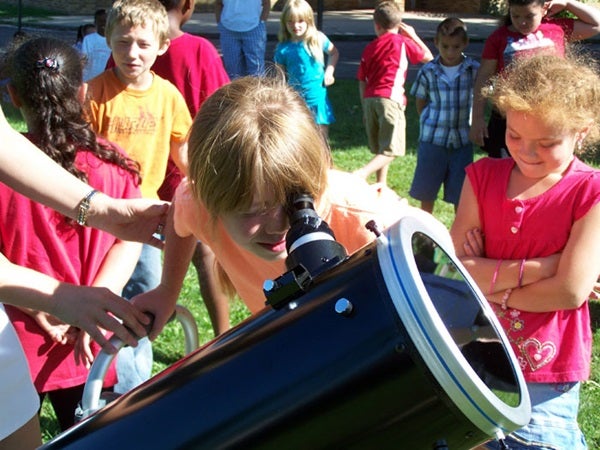The transformation from normal to “Galileo-like” was not easy. They had to attend two classes presented by COC staff members and conduct two star parties with loaner scopes. But all 40 winners completed their requirements and are poised for graduation. In fact, participants have attended optional classes on using Starry Night, public viewings at the COC, and construction parties (I couldn’t put all 40 telescopes together by myself!). One winner created a web site to coordinate group star parties as well as share information and experiences. Several have even gotten media coverage for their events. As their 3-month training comes to a close, the 40 Galileos have delivered 120 programs and reached over 5,000 people – most of whom had never seen through a telescope before.
This passion for the program is infectious. Terry Haynes-Tony, who teaches art at a local elementary school, embodies the transformation this program has engendered. She regrets getting into the field so late.
“I just had to apply to share this opportunity with the community in which I work,” she says.
Beyond star parties, her ultimate goal is to start an Art in Astronomy Club at her school, and she’s off to a great start. Haynes-Tony has logged 12 events through the program, including a solar extravaganza with her entire school, star parties, and every COC special event.
“I think the biggest surprise of all is how a simple tube with mirrors and lenses can attract complete strangers, create meaningful conversations and bond individuals,” says Haynes-Tony.
Chad Husting, a high school science teacher, relishes his new role in the community as a “Galileo.”
“I was stopped in the library a couple weeks after I did a sidewalk astronomy program there,” Husting says. “A 5-year-old girl came up to me and said, ‘Hey, aren’t you the star guy? I had fun with your telescope.'”
Husting will share the telescope at home football games. A newly hired astronomy teacher will borrow it to use as a training aid. Being able to use the telescope outside the classroom, in an informal way, has helped Husting gain perspective on the field of education.
“Every time a person looks through the eyepiece it becomes an incredible teachable moment,” Husting says. “That reaction reenergizes me as a teacher and makes me want to work harder to recreate this type of excitement in my own classroom.”
Alice Kahn has been using her telescope at the retirement community where she works as a speech-language pathologist. Kahn often works with adults who have dementia or other neurological conditions that may limit speech. “I wanted to use astronomy to encourage them to keep learning something new,” Kahn says. “Stargazing has been an activity they could enjoy without needing verbal communication.”
Matthew Worsham’s journey to become a Galileo was similar to most. A high school student with an interest in science, Matthew first observed the Moon and stars through his dad’s telescope. After being selected as a Galileo, now it’s his turn to be the teacher. Worsham recalled: “One night I was out on my driveway just looking at the Moon with the telescope and some kids from my neighborhood saw me and asked me what I was doing. I explained it to them and asked them if they would like to take a look. They were so fascinated by what they saw that they kept getting more people to come over. I ended up having an impromptu star party.”
The theme from so many participants is that they want to give back to the community. Although the telescope makes viewing possible, it is the passion of the participants that is truly making this a successful project. Thanks to Astronomy magazine for selecting this program as the recipient of the 2008 Out-of-This-World Astronomy Award. Its support helped jump-start and legitimize the program.
The 40 Galileos graduated September 11 at the Cincinnati Observatory. We lined up all 40 winners with their Dobsonians while renowned astronomy historian Owen Gingerich shared a few stories about his first telescope at the ceremony.
Dean Regas is the Outreach Astronomer at the Cincinnati Observatory Center. He can be reached at deanobservatory@zoomtown.com and writes an astronomy/mythology blog at: http://www.cincinnatiobservatory.org/deanspace.html












